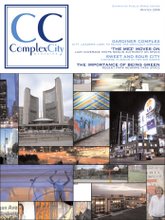Grass roots take hold in downtown square
 BY D. LAXMIDAS MAKWANA
BY D. LAXMIDAS MAKWANA
Toronto Sun columnist Joe Warmington finds enjoying the finer things helps his creative process: Coffee with friends punctuated with a first-rate cigar in Yonge-Dundas Square.
On another occasion Warmington spotted Mayor David Miller mingling with passersby among the granite slabs dotted by water fountains. At that moment he realized the potential for the location to bring people together.
“I looked at Nathan Phillips Square and it certainly has its own history and importance to the city,” he said. “It just isn’t what Dundas Square’s become which is a real grass roots place.”
His vision of seeing the square filled with a sea of red-clad Canadians showing support for Canadian soldiers in Afghanistan would come to be over the next seven days. For Warmington using Yonge-Dundas Square as the site of a rally was an organic conclusion.
In its infancy Yonge-Dundas Square has become the anchor point of the Yonge Street corridor that runs through Toronto’s downtown core. Three years after it was officially opened, Yonge-Dundas Square continues to define its identity as a meeting place within Toronto and against world-renowned public spaces such Times Square in New York City.
Taylor Raths, general manager of Yonge-Dundas Square, believes the space can live up to more than its moniker.
“We call ourselves the heart of the city and I really want us to be that,” he said. “Not just geographically, I want us to feel like it’s a spot that belongs to the people. And it does belong to them.”
To accomplish his goal Raths spearheads a number of events sponsored by the public and private sector. On weekends Yonge-Dundas Square is filled with vendors and shoppers active in the city’s artisan market. On weekday afternoons a concert series shares the space with corporate-sponsored events promoting new products or services. Raths hopes to find the right mix of event planning so the square becomes a meeting point in the city.
Still his efforts have yet to sway the public. With the plot of land surrounded by billboards and other advertisements, pedestrians pass by and see the square as another place to shop instead of stopping to enjoy its features.
“I think the general public doesn’t really understand the one acre of land (of) the square is the only public portion,” Raths said. “The billboards that surround us make us look like downtown Tokyo, but there really isn’t any association of the billboards that surround the square and the land itself.”
While Raths feels signage detracts from Yonge-Dundas Square, Times Square in New York City has built its identity around its bright lights.
Over 102 years Times Square has defined itself as a meeting place for citizens of the world. During the 1990s the square went through an intense regeneration evicting massage parlours, strip clubs and an unwanted criminal element. In turn multinational corporations moved in and lit up the sidewalk with billboards creating an environment advantageous to commerce and tourism.
Ellen Goldstein, vice-president of policy, planning and design for the Times Square Alliance, says the billboards are just a part of the experience.
“It such a unique visual experience when you come here,” Goldstein said. “We have a sense of constant entertainment, whether that means you’re coming here to go to the theatre or you’re here to see something on the street. It’s active 24 hours a day. There’s always something going on.”
Because of the activity Times Square has become a natural meeting place for New Yorkers.
“We had a wonderful thing happen during the World Cup,” Goldstein said. “It was Ghana versus Italy and there was a gathering of Ghanaians in the middle of Times Square watching on the big screen … When Ghana won people were hysterical. It was a completely organic gathering of people.”
Organic appeal is what Yonge-Dundas Square is attempting to provide to Torontonians.
When Joe Warmington filled Yonge-Dundas Square with his sea of red the spot took another step towards becoming a meeting place for the city.
“I think our rally was one of that place’s finest hours,” Warmington said. “I think it will be remembered as that.”





No comments:
Post a Comment